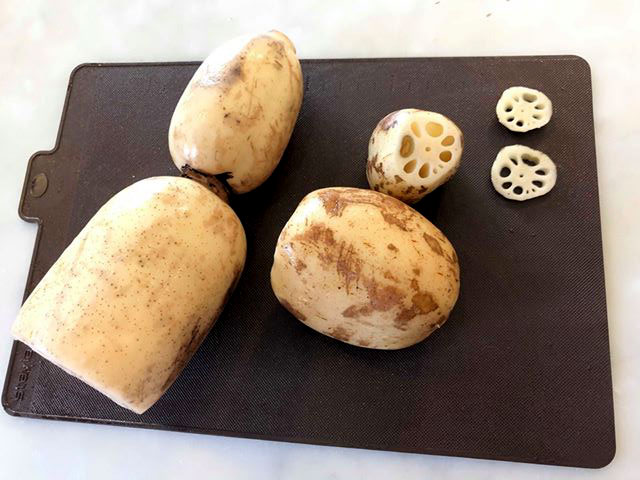Japanese Herb Series 6 : "Lotus Root" ,The lucky herb appears in New Year's dishes
We have only a week left in 2020. This year, there has been a global pandemic of coronavirus, which may have led to various changes in your life, I think.
I introduce lotus root with a prayer that next year will be a brighter year with a ray of hope for you.
Lotus root is in season from fall to winter and is eaten in simmered, stir-fried and tempura.
It also appears in New Year's Osechi dishes, because it considered a good omen, as its perforated shape allows one to see into the future.
It is called " Hasu" as a plant and "Renkon" as a food in Japan.
The history as Hasu (Lotus)
It is believed that the lotus was introduced to Japan via India and China. It is also described in the Kojiki (Record of Ancient Matters).
▲Lotus Loot Pond in Tsuchiura City, Ibaraki Prefecture
The history and efficacy as Renkon (Lotus root)
According to ”Hitachi Province Fudoki"(the local reports of Hitachi Province) in 723, "Once upon a time, the lotus root from the swamp formed by the pool of water flowing from the heavens had a good taste that cannot be tasted anywhere else, and those who were sick would be healed instantly if they ate the lotus root from this swamp".
Today, the largest production of lotus root in Japan is in Ibaraki Prefecture, which was once called "Hitachi Province". The harvest is at its peak in late autumn and winter.
▲Stewed chicken with lotus root
Lotus root has many efficacies such as antioxidant, antibacterial, hemostatic, sedative, nourishing, tonic, and allergy suppressing effects, protecting and repairing the mucous membranes of the stomach and digestive organs, and calming the mind.
It is also said to be effective for high blood pressure, all kinds of blood problems and women's diseases.
If you use it to control allergies, such as hay fever, it is recommended to eat 25-30 g (1-2 slices) every day for more than three months.
You can enjoy lotus root with various textures depending on the cooking method, such as stewed, pickled, fried, etc. How about adding lotus root to your food regimen?
Lotus Root Drink Recipe
Grated juice of lotus root
A small amount of lotus root
<How to make>
Wash and grate the raw lotus root with its skin on. Squeeze out the grated juice and drink it as it is, or add grated ginger or brown sugar to taste, and pour hot water over it.
<Efficacy>
For colds and coughs, nosebleeds, swelling, hangovers, etc.
References
『野菜は薬だ』岩尾裕之、小林正夫 共著 社団法人農山漁村文化協会
『からだに効く和の薬膳便利帳』武鈴子著 家の光協会
『日本のハーブ事典』村上志緒編 東京堂出版
『免疫力を上げて一生健康』順天堂大学名誉教授 奥村康監修 株)宝島社
『ハーブのわかる事典』ジャパンハーおせち料理に登場する縁起の良いハーブ『レンコン』
Notes
Although there are a variety of active ingredients in herbs, some herbs cannot be used during pregnancy, breastfeeding, or if you have a pre-existing medical condition. Please consult with your physician and use your own judgment. The author is not responsible for any loss or impairment caused by the use based on this blog.







Comments
Post a Comment